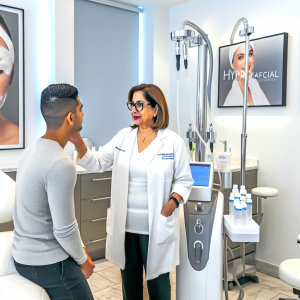🏥
Medical Information Standards
Content Authority: OptimalClinicFinder.com is a comprehensive medical directory platform connecting patients with qualified Microneedling providers. Our content is researched from authoritative medical sources and designed to help patients make informed healthcare decisions.
How Dr Pen Microneedling Technology Works: Clinical Mechanism
The Dr. Pen microneedling system utilizes advanced vibrating needle technology to create precise, controlled micro-channels in the skin at depths ranging from 0.25mm to 3.0mm. This controlled injury mechanism triggers the body’s natural wound healing cascade, stimulating fibroblast activation, collagen synthesis, and elastin production. The vibrating action of Dr. Pen devices, operating at 1,000-1,500 oscillations per minute, ensures consistent needle penetration while minimizing drag and tissue trauma.
The physiological response begins immediately upon needle penetration, initiating the inflammatory phase of wound healing. Within 24-48 hours, growth factors including PDGF (platelet-derived growth factor), TGF-β (transforming growth factor-beta), and VEGF (vascular endothelial growth factor) are released, promoting cellular migration and angiogenesis. This cascade continues for 4-6 weeks post-treatment, with new collagen formation peaking at 30-45 days. The remodeling phase extends for up to 6 months, resulting in progressive skin texture improvement and scar reduction.
💡
Did You Know?
Clinical studies show that Microneedling patients achieve excellent results when combined with professional-grade aftercare products.
Clinical Research and Evidence Base for Microneedling
Extensive clinical research supports the efficacy of professional microneedling systems for multiple dermatological conditions. The landmark study by Doddaballapur (2009) demonstrated 80% improvement in acne scar appearance following a series of microneedling treatments. Subsequent randomized controlled trials have confirmed these findings, with Fabbrocini et al. (2014) reporting significant improvements in atrophic acne scars using 1.5mm needle depth protocols.
Meta-analyses of microneedling studies reveal consistent outcomes across diverse patient populations. A 2018 systematic review published in the Journal of Cosmetic Dermatology analyzed 19 studies encompassing 602 patients, demonstrating mean improvement scores of 75% for acne scarring and 68% for photoaging markers. Long-term follow-up studies extending to 12 months post-treatment show sustained improvements, with patient satisfaction rates consistently exceeding 85%. Recent comparative studies have established microneedling as equivalent or superior to fractional laser treatments for many indications, with significantly reduced downtime and complication rates.
Professional Treatment Protocols and Clinical Management
Successful Dr. Pen microneedling treatment begins with comprehensive patient evaluation and customized protocol development. The initial assessment includes detailed medical history, current medication review, skin type classification using the Fitzpatrick scale, and photographic documentation. Contraindications must be carefully screened, including active infections, autoimmune conditions, bleeding disorders, and current isotretinoin use within the past 6 months.
Standard treatment protocols typically involve 3-6 sessions spaced 4-6 weeks apart, allowing adequate healing between treatments. Needle depth selection follows established guidelines: 0.25-0.5mm for superficial rejuvenation and product absorption, 1.0-1.5mm for moderate scarring and wrinkles, and 2.0-2.5mm for deep acne scars and surgical scar revision. Pre-treatment preparation includes topical anesthetic application 30-45 minutes prior to treatment and thorough skin cleansing with medical-grade antiseptic solutions. Post-treatment care protocols emphasize gentle cleansing, medical-grade moisturizers, and strict sun protection for optimal healing and results.
💡
Quick Tip
Microneedling works best when combined with healthy lifestyle choices for optimal results.
Safety Profile and Comprehensive Risk Management
The safety profile of professional microneedling with Dr. Pen devices is well-established, with serious adverse events occurring in less than 0.1% of treatments when proper protocols are followed. Common immediate side effects include erythema (redness) lasting 24-72 hours, mild edema, and pinpoint bleeding during treatment. These expected responses indicate appropriate treatment depth and typically resolve without intervention.
Risk mitigation strategies focus on proper patient selection, sterile technique, and appropriate depth selection. Infection risk is minimized through single-use cartridge protocols, proper skin preparation, and post-treatment care instructions. Hyperpigmentation risk, particularly in darker skin types (Fitzpatrick IV-VI), is managed through conservative depth selection, appropriate pre-treatment preparation with tyrosinase inhibitors, and strict post-treatment sun protection protocols. Scarring risk is virtually eliminated when treatments are performed by qualified providers using appropriate needle depths and following established safety guidelines.
Cost Analysis and Insurance Coverage Considerations
Dr. Pen microneedling treatment costs vary significantly based on geographic location, provider credentials, and treatment complexity. Professional treatments typically range from $150-$500 per session, with package pricing often available for multiple session protocols. Factors influencing cost include provider qualifications, facility overhead, treatment area size, and adjunctive therapies such as platelet-rich plasma (PRP) or growth factor serums.
⚠️
Safety First
Always consult a qualified medical professional before starting Microneedling. Results vary by individual.
Most insurance plans classify microneedling as cosmetic treatment and do not provide coverage for aesthetic applications. However, coverage may be available for medical indications such as traumatic scarring, surgical scar revision, or dermatological conditions with functional impairment. Flexible spending accounts (FSA) and health savings accounts (HSA) can often be utilized for microneedling treatments, providing tax advantages for qualified medical expenses. Many providers offer financing options through medical credit companies, making treatment accessible with monthly payment plans.
Provider Selection and Quality Assurance Standards
Selecting a qualified provider is crucial for safe and effective Dr. Pen microneedling treatment. Optimal providers include board-certified dermatologists, plastic surgeons, or licensed aestheticians working under physician supervision. Key qualifications include formal microneedling training certification, bloodborne pathogen training, and experience with at least 100 microneedling procedures. Providers should maintain current CPR certification and have protocols for managing adverse reactions.
✓
Why Choose Microneedling?
●
Clinically proven
●
FDA approved
●
Minimal downtime
●
Long-lasting
Quality assurance indicators include proper facility licensure, use of FDA-cleared devices, adherence to single-use cartridge protocols, and comprehensive consultation processes. Reputable providers will conduct thorough skin assessments, discuss realistic expectations, provide detailed aftercare instructions, and offer appropriate follow-up care. Red flags include non-medical settings offering deep microneedling, cartridge reuse practices, inadequate consultation processes, or providers lacking proper credentials and training verification.
Dr Pen Microneedling Pen: Advanced Technology Features
The Dr. Pen microneedling pen incorporates several technological advantages that distinguish it from traditional dermaroller systems and competing devices. The adjustable needle depth mechanism allows precise control from 0.25mm to 3.0mm in 0.25mm increments, enabling customized treatment protocols for different skin areas and conditions. The high-frequency vibration system reduces tissue drag and ensures uniform needle penetration, minimizing patient discomfort and improving treatment consistency.
Professional Dr. Pen models feature rechargeable battery systems providing consistent power throughout treatment sessions, LED displays showing depth settings and battery status, and ergonomic designs reducing provider hand fatigue during extended treatments. The proprietary cartridge system ensures optimal needle sharpness and sterility, with bayonet-style connections preventing cartridge loosening during treatment. Advanced models include speed control settings allowing providers to adjust penetration frequency based on treatment area sensitivity and patient tolerance levels.
📚 Medical Authorities & Professional Standards
All Microneedling procedures should be performed by licensed medical professionals following established clinical guidelines and safety protocols.
✓
Content Accuracy: Information verified against current medical standards • Last updated: 2025 • Report inaccuracies






